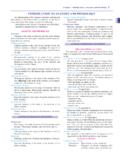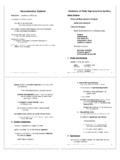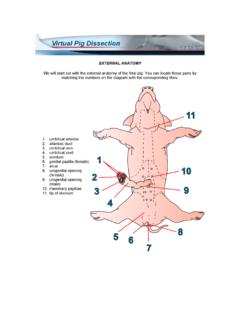Transcription of INTRODUCTION TO ANATOMYAND PHYSIOLOGY …
1 13 Chapter 1 INTRODUCTION to anatomy and PhysiologyAnatomy1 Define anatomy . anatomy is the study of structure andstructural relationships of the body and / or its cellular anatomy . Cellular anatomy is the study ofthe structure of the cell. 3 Define cytology. Cytology is the study of the structure,function, pathology, life cycles, and life history of developmental anatomy (embryology).Developmental anatomy is the study of the structuraldevelopment of the gross anatomy . Gross anatomy is the study ofstructures which can be seen with the unaided histological anatomy .
2 Histological anatomy is thestudy of the structure of tissues. 7 Define histology. Histology is the study of the structure, asseen microscopically, and function of microscopic anatomy . Microscopic anatomy is thestudy of structures with the aid of a regional anatomy . Regional anatomy is the study ofspecific portions of the body (regions).10 Define systemic anatomy . Systemic anatomy is the studyof the structure of the body's Define surface anatomy . Surface anatomy is the study ofthe structure of the body's Define PHYSIOLOGY . PHYSIOLOGY is the study function of theliving body and/or its Define cell PHYSIOLOGY .
3 Cell PHYSIOLOGY is the study of thefunction of cells (a branch of cytology).14 Define pathology. Pathology is the study of disorderedfunctions or Define systemic PHYSIOLOGY . Systemic PHYSIOLOGY is thestudy of the function of the body's Define special (organ) PHYSIOLOGY . Special (organ) physi-ology is the study of specific organs of the What does complementarity of anatomy and physiologyrefer to? Complementarity refers to the interrelationship ofstructure ( anatomy ) and function ( PHYSIOLOGY ). Organizational Levels18 List in sequence (lowest first) the six hierarchical levels ofanatomy and PHYSIOLOGY .
4 (1) Chemical level(2) Cellular level(3) Tissue level(4) Organ level(5) Organ system level(6) Organism level19 How does the chemical level (atoms, molecules, and theirinteractions) relate to cells? Chemical interactions play anessential role in the structural and functional aspects of Cells are built on the chemicallevel and are organized intothe What are the three components of the cell theory?(1) all living things are made of cells (2) cells are the basic units of life(3) cells come only from preexisting cells22 Tissues are built on the cellularlevel and are organizedinto the What are the four fundamental groups of tissues?
5 (1) epithelial tissue (2) connective tissue(3) muscular tissue(4) neural tissue24 Organs are built on the tissuelevel and are organized intothe organ Organ systems are built on the organlevel and are organ-ized into the Match the following systems with their components:Cardiovascular systemMuscular systemDigestive systemNervous systemEndocrine system Respiratory systemFemale reproductive systemSkeletal systemIntegumentary system Urinary systemLymphatic system Male reproductive systemNervous systemBrain, spinal cord, nerves, and receptors Cardiovascular Heart, blood vessels, and bloodUrinary systemKidneys, ureters, urinary bladder, andurethra Lymphatic systemLymph nodes, lymphatic vessels andtheir fluid called lymph, tonsils, spleen,and thymusDigestive systemMouth, esophagus, stomach, smallintestine, large intestine.
6 Anus, andaccessoryRespiratory systemNasal cavity, voice box (larynx), wind-pipe (trachea), and lungsDigestive systemOrgans such as salivary gland, pancreas,liver and gallbladderEndocrine systemOrgans which produce hormones(chemical messengers) which includepituitary, testes, ovaries, thymus, thy-roidFemale reproductiveOvaries, fallopian tubes, uterus, andvaginaMuscular systemSkeletal musclesSkeletal systemSkeletonIntegumentary systemSkin, hair, nails, sweat glands and oilglandsMale reproductiveTestes, ductus (vas) deferens, prostate,seminal vesicles, and penisINTRODUCTION TO anatomy AND PHYSIOLOGYWORKSHEETS - KEYC hapter 1 INTRODUCTION to anatomy and Physiology27 Match the following systems with their functions.
7 Cardiovascular systemDigestive systemEndocrine system Female reproductive systemIntegumentary system Lymphatic system Male reproductive systemMuscular systemNervous systemRespiratory systemSkeletal systemUrinary systemRespiratory systemDelivery of air to lungs for oxygen andcarbon dioxide exchange between airand bloodNervous systemImmediate control of systems, personal-ity, emotions, systemIncludes the production, storage, andelimination of urine, which involvesregulation of water, electrolytes, andblood systemIncludes the skeleton which supports,protects, provides for storage of calci-um, and serves as a site of blood cellproductionEndocrine systemLong-term regulation of systems by pro-duction and release of hormonesMuscular systemMovement of the body and involved inbody temperature regulationDigestive systemProcessing and absorption of nutrientsFemale reproductiveProduction of egg, implantation anddevelopmentLymphatic systemProduction of lymphocytes for immuni-ty, and collects, filters, and transportsfluid (lymph)
8 Male reproductiveProduction of spermIntegumentary systemProtection (by skin, hair, etc.), site ofsensory receptors, involved in bodytemperature control, Transport of blood; including cells,nutrients, wastes, gases, hormones, In reference to Figure , identify levels #1 - #6. 1 Chemical levelOrgan level2 Cellular level5 Organ system level3 Tissue level6 Organism levelCharacteristics of Human Life29 Define metabolism. Metabolism is generally defined asthe sum of all the physical and chemical processes thatpertain to the body's What are the two major divisions of metabolism?
9 (1) Catabolism(2) Anabolism31 Define catabolism. Catabolism is the destructive phase ofmetabolism. 32 Define anabolism. Anabolism is the constructive phase ofmetabolism. 33 What are three ways growth may occur?(1) Increase in the number of cells(2) Increase in the size of the cells(3) Increase in the amount of extracellular material34 Define differentiation. Differentiation is the process wherecells acquire an individual identity that results from pro-gressive Define responsiveness. Responsiveness is the ability toreact and depends upon irritability, a response to a Motion begins with controlled molecular actions withinthe List five areas where movements are seen.
10 (1) Movements within the cell(2) Movements of the cell(3) Movements of a tissue(4) Movements of an organ(5) Movements of the body38 What are two processes of cell reproduction?(1) Mitosis(2) Meiosis39 What does meiosis give rise to? Meiosis produces gametes 14




